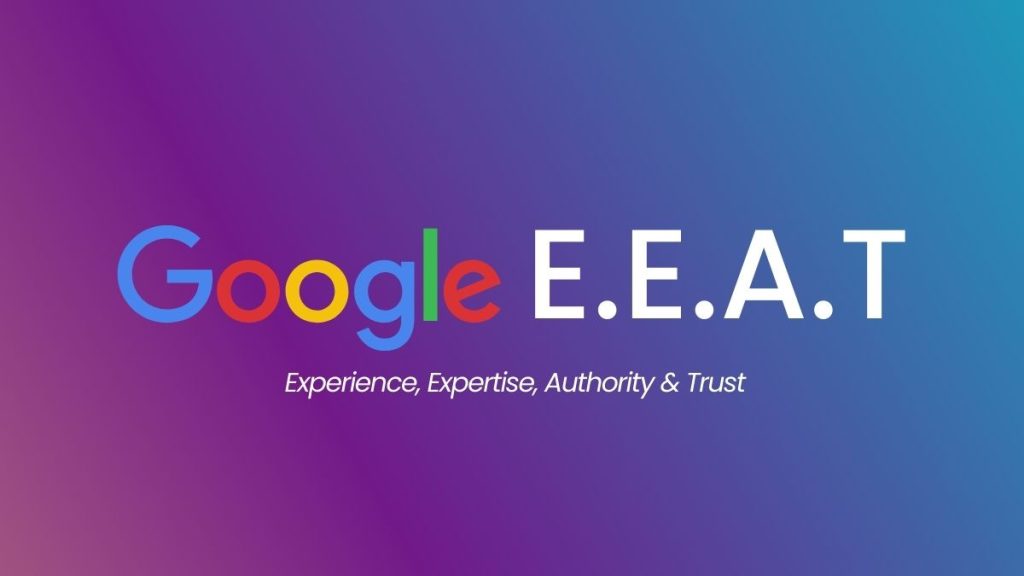The evolving field of search engine optimisation (SEO) has a new acronym and buzzword: E-E-A-T. These four letters are the foundation and principles of quality for the content produced and the creators of the content where Google can intervene to decide whether it fits for a top spot in search results. The award-worthy content is high in Experience, Expertise, Authoritativeness, and Trustworthiness (E-E-A-T). With Google search algorithm complexity rising every second, it is crucial for any business or individual who craves for more visibility, authority, and profits online know and apply these fundamental principles of Google ranking. This article provides an in-depth Google guide with the four qualities of E-E-A-T and how to use it to your competitive advantage.
Enhance Content Quality with Expertise
You need to demonstrate E-A-T – expertise, authoritativeness, and trustworthiness – so your site content will rank highly in search results. Media sites that display the bylines of well-known and widely published experts or a team of subject-matter experts promoting authoritative and unbiased journalism will fare better than niche websites that anonymously publish content on a variety of topics by a team of ghostwriters. The E-E-A-T guidelines, which are targeting health-related, financial, and legal websites that can have adverse outcomes if the content is inaccurate, promote authoritative and trustworthy content. Display badges on your website showcasing your qualifications, certifications, and relevant experience will boost credibility in SEO.
To do this effectively means creating author bios where your content-creators’ academic credentials and professional experience are front and centre, which should include their educational background, work experience, plus any relevant certifications if applicable. Consider getting experts to review your content, especially if you are providing opinion pieces in a more regulated industry This goes beyond Google’s E-E-A-T criteria. It also enhances your brand’s C-R-E-D-I-B-I-L-I-T-Y – the overall level of trust a consumer or site visitor has in your brand and its content.
Build Authoritativeness through Backlinks and Mentions
It’s also why it places high value on authoritativeness, which is often evidenced by the authority and relevance of your backlinks, and which is one of the key components of Google’s E-E-A-T at the domain and page levels. After all, if other reputable sites and publications link out to yours when they refer to your content, it’s clear to Google that there’s a reason others are source-validating your content. That means you’re providing something authoritative to the web that Google is heavily incentivised to support by increasing the footfall to your site. As noted above, a big portion of Google’s E-E-A-T framework relates back strongly to Google’s core mission, and the wider mission of ‘helping the world’s users to find the most relevant and robust information’.
And to build authoritativeness, emphasise the number of links (or backlinks, as they’re known in the industry) coming to your site – but not from any site, from high-authority sites in your industry. These can be attained through guest blogging, partnering with influencers and creating content that’s highly linkable for readers, or that’s referenced by people writing about your industry or other articles or news pieces relating to your domain. Being ‘mentioned’ in industry articles or in-the-news pieces is incredibly powerful as it demonstrates that your site is seen as a trustworthy source that covers a topic well. By working this into the SEO conversation, you’re more likely to become an accepted ‘quality site’ and your site stands more of a chance of being protected from the effects of Google Phantom and other algorithm updates targeting content with very low perceived quality. When it comes to authoritativeness, this metric is about the quality of endorsements versus quantity.
Cultivate Trustworthiness through Transparency and Integrity
Because trustworthiness is an important part of the Google E-E-A-T framework, it is another key to unlocking the potential of your site as assessed by Google. Google looks at trust through the lens of transparency and integrity – transparency meaning that you are who you say you are, where your stated information comes from, how your user data has been handled, and so on; integrity looking at the overall integrity of your website. Trust signals that show up on your site, such as clear privacy policies, secure website certificates (HTTPS), and transparent business information all contribute to building trust.
Make sure your About Us and Contact Us pages are detailed about your website and your business. Can potential and current followers see your mission, who operates the business, and how they can contact you? Is there a discussion of your professional or observed experience and background? Display if there are any conflicts of interest (such as if the content involves reviews or product endorsements). Clearly marking your contact information – especially if you have a physical location – can help; it’s better for your website if you have updated physical addresses and phone numbers. Customer reviews on your brand and testimonials from your customers can help your site seem more trustworthy. If any third-party organisations have provided a certification about your business, mention them. Displaying these emphasises the E-E-A-T of your site, bringing you that much closer to higher rankings with Google.
Leverage User Experience to Enhance E-E-A-T
In fact, UX (user experience) is something Google weighs quite heavily in E-E-A-T and can mean the difference between a client staying on a site or finding it hard to navigate and quickly bouncing off ( for). When searching for something, valuable UX not only makes their experience a pleasurable one; it can also send another positive signal to Google about your site’s trustworthiness. Dismal UX with high bounce rates tells Google that there is something wrong with your site. This may very well cause your site to fall, or be relegated, in the rankings. Google algorithms, and even specific updates like the one seen on Google Phantom, are finding more and more of these sites that provide a poor UX and punishing them.
You can also ensure a good UX and E-E-A-T by making your website design clean, easy to navigate, and light-loading so that it performs well on all devices. Make sure your site loads fast, and the content is high-quality, with easy navigation and clear language that serves user intent well. Use structured data and Schema markup to help search engines better understand your content and serve more visually engaging search results. A good UX will not only please your site visitors but, by extension, will signal E-E-A-T to Google.
Update and Maintain Content Regularly
Google looks for an element called Recency – which means that if you can make sure that every time your content gets updated, it’s like kitchen messing with that pie. Actually, it’s better: because even if Google doesn’t refresh its assessment of your site every day, they know your site’s recency has increased. Stale content damages your site. This could hurt your site especially if the information changes quickly – yes, even the bread-making business evolves. The other interesting element of Recency is that it’s where Expertise and E-A-T overlap. The US criminal court system allows anyone to represent themselves if they have ‘good cause’. In other words, Google will expect you to have an argument for why you should be in a position of authority.
Set a schedule for conducting content audits and edit older content periodically to ensure that none of it has fallen out of date due to changes in facts, statistics or overall context. Make sure references and quotes you’ve provided are still current. Build upon older content too by incorporating new findings or insights that deepen or broaden the value of any blog post – whether it’s years or just months old. Regularly updating content also gives you a chance to re-optimise your content for relevant SEO keywords, as well as for the other ‘on-page SEO’ factors that will further strengthen your website’s status and visibility with search engines like Google. All this should help meet the letter and the spirit of Google’s E-E-A-T requirements, but it will also send a signal to your audience that your website provides the most up-to-date information, demonstrating that you will continue to curate and revise content over time.
Build a Strong Online Reputation
As a successful online reputation management practitioner, I can attest that having a healthy and – most importantly – positive online reputation is critical to fulfilling Google’s extensive E-E-A-T criteria. Reputation is an asset that is earned and built over time, based on your reputation on the internet, which ultimately boils down to the sum of its parts. Reputation is a combination of the reviews you receive from your customers (which coincidentally provides the best and most comprehensive assessment of quality, at least when implementing the appropriate collections), your brand presence on social media, and how you and your brand are perceived your customers. Your reputation is manifested in these external signals that Google continues to use to assess the trustworthiness and authority of your site on the internet. The longer you take care of your reputation online, the healthier your Google E-E-A-T profile will be – and a positive reputation will not only help you in this sense. It will directly impact your ability to rank higher on the Google SERPs, as described in the foregoing principles.
You can also maintain a strong reputation by getting actively involved in an online community. Respond to conversations with customers on both social media accounts and review sites. Reply to both positive and negative reviews quickly and professionally with gratitude or a direct line of communication with assistance. Additionally, prompt satisfied customers to post favourable reviews, or even videos or testimonials that you can feature on your site. Monitoring mentions of your brand (entirely out of your control) on the web and exercising crisis response is also a part of online reputation management, though it deals with publicity issues that are beyond the scope of this post. On the whole, cultivating a positive online reputation gives you added SEO credibility by correlating you to something Google considers to be another of the E-E-A-T pillars: trust
Conclusion:
Google’s E-E-A-T framework is a powerful tool for anyone looking to improve their search engine rankings. By focusing on enhancing expertise, building authoritativeness, cultivating trustworthiness, improving user experience, maintaining content, and strengthening your online reputation, you can effectively leverage E-E-A-T to your advantage. These strategies not only align with Google’s current standards but also prepare your site to withstand future algorithm updates, including those similar to Google Phantom. Implementing these practices will not only improve your Google SEO expertise but also solidify your position as a credible and authoritative source in your industry.






